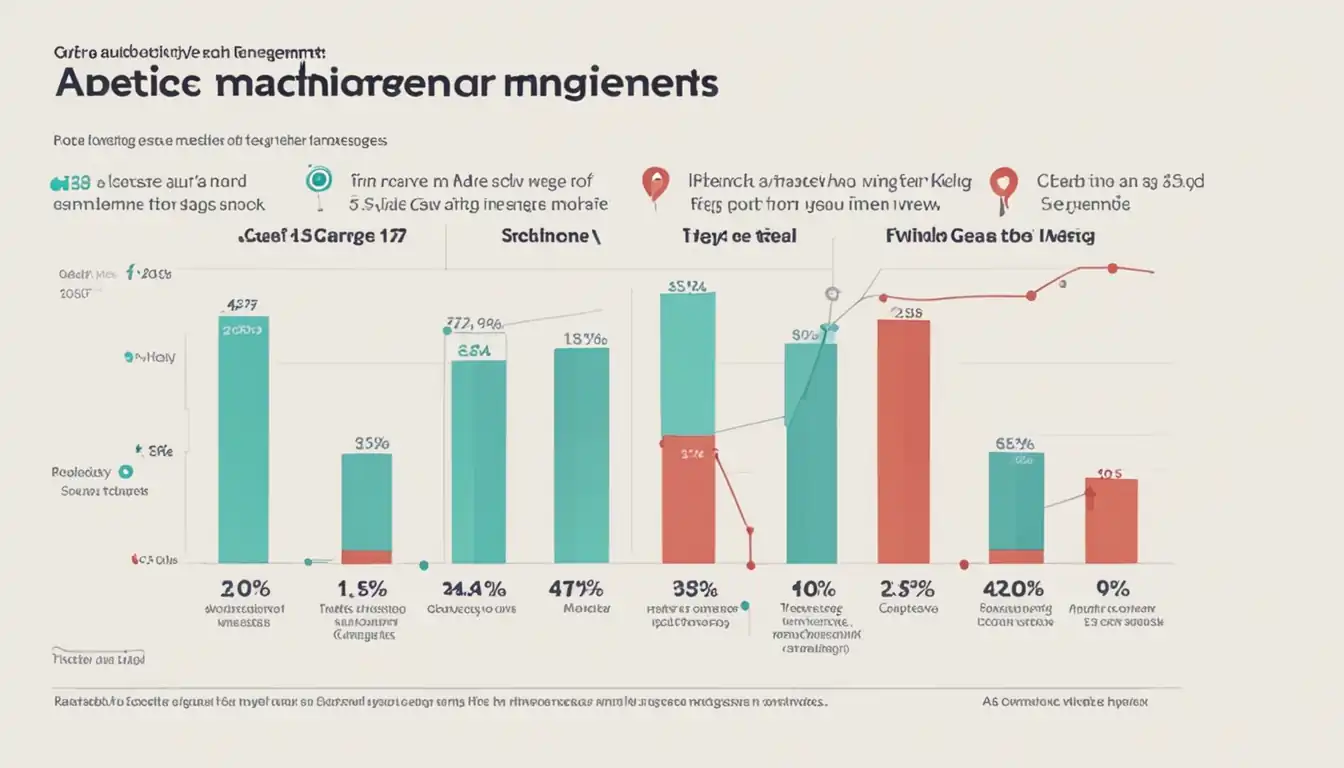Decoding Your Target Audience: A Strategic Approach for Marketers

Understanding your target audience is crucial for any marketing strategy. By decoding who your audience is, you can tailor your messaging and content to better resonate with them. In this post, we'll delve into the strategic approach for marketers to decode their target audience and create impactful marketing campaigns.
Understanding the Concept of a Target Audience

When it comes to content-driven SEO, understanding the concept of a target audience is crucial. This means knowing who you're talking to and tailoring your content to their specific needs and interests.
The Importance of Knowing Who You're Talking To
Knowing your target audience allows you to create content that resonates with them. By understanding their demographics, behaviors, and preferences, you can craft messages that are more relevant and engaging. This not only helps in attracting the right kind of traffic to your site but also in converting them into customers or clients.
The Misconceptions About Target Audiences
There are some misconceptions about target audiences that need to be addressed. One common misconception is that a target audience is too narrow and limits your reach. In reality, defining your target audience helps you focus your efforts and resources on those most likely to be interested in your products or services. It's about quality over quantity.
Another misconception is that a target audience is static and unchanging. In truth, a target audience can evolve over time, and it's important to regularly reassess and adjust your strategies to ensure you're still reaching the right people.
Understanding the concept of a target audience is the foundation of effective content-driven SEO. It's about creating content that speaks directly to the people who are most likely to benefit from what you have to offer.
The Anatomy of a Target Audience
When it comes to understanding your target audience, it's important to consider both demographic and psychographic factors.
Demographic Factors: Age, Gender, Income, and More
Demographic factors include basic information such as age, gender, income, education level, marital status, and occupation. Understanding these factors can help you tailor your content to better resonate with your audience. For example, if your target audience is primarily young adults, you may want to use language and references that are relevant to that age group. On the other hand, if your audience is predominantly female, you may want to focus on topics and themes that are of particular interest to women. It's crucial to conduct thorough research to accurately identify the demographic makeup of your target audience.
Psychographic Profiling: Interests, Values, and Lifestyles
Psychographic profiling delves deeper into the psychological and emotional aspects of your target audience. This includes their interests, values, attitudes, and lifestyles. By understanding these factors, you can create content that truly resonates with your audience on a personal level. For example, if your target audience values sustainability and environmental consciousness, you can tailor your content to highlight your brand's eco-friendly practices. By understanding the psychographic profile of your audience, you can create content that truly speaks to their interests and values.
Understanding the anatomy of your target audience is crucial for creating content that effectively engages and resonates with them. By considering both demographic and psychographic factors, you can tailor your content to better meet the needs and preferences of your audience.
The Role of Market Research in Identifying Your Audience

Market research plays a crucial role in identifying your target audience. By utilizing both quantitative and qualitative methods, businesses can gain valuable insights into the needs, preferences, and behaviors of their potential customers.
Quantitative Methods: Surveys and Analytics
Surveys are a common quantitative method used to gather data from a large sample of the population. By asking specific questions related to demographics, purchasing habits, and brand preferences, businesses can obtain numerical data that can be analyzed to identify trends and patterns.
Analytics, on the other hand, involve the use of tools such as Google Analytics to track and measure website traffic, user behavior, and engagement metrics. This quantitative data can provide valuable information about the online behavior of your target audience, helping you tailor your digital marketing efforts to better reach them.
Qualitative Techniques: Interviews and Focus Groups
Interviews allow businesses to have in-depth conversations with individuals from their target audience. This qualitative method provides rich, detailed insights into the thoughts, feelings, and motivations of potential customers, helping businesses understand the underlying reasons behind their behaviors.
Focus groups bring together a small group of individuals from the target audience to discuss specific products, services, or marketing campaigns. This qualitative technique allows businesses to observe how their audience interacts with and responds to different stimuli, providing valuable feedback that can inform future marketing strategies.
In conclusion, both quantitative and qualitative market research methods are essential for identifying and understanding your target audience. By utilizing a combination of these techniques, businesses can gain a comprehensive understanding of their audience's needs and preferences, allowing them to tailor their products and marketing efforts to better meet their customers' expectations.
Segmenting Your Audience for Greater Impact
When it comes to creating effective content-driven SEO strategies, segmenting your audience is a crucial step for achieving greater impact. By dividing your audience into smaller, more targeted groups, you can tailor your content to better meet their specific needs and preferences. This not only improves the relevance of your content but also increases the likelihood of engaging and converting your audience.
The Basics of Market Segmentation
Market segmentation involves dividing a broad target audience into smaller, more homogeneous groups based on certain characteristics such as demographics, behaviors, or psychographics. By understanding the unique traits and preferences of each segment, businesses can create content that resonates with each group on a deeper level. This can lead to higher engagement, increased brand loyalty, and ultimately, better business outcomes.
Case Studies: Successful Audience Segmentation in Action
To illustrate the impact of audience segmentation, let's take a look at some real-world examples of successful implementation. Company A, a fashion retailer, segmented its audience based on age and style preferences, allowing them to create personalized content and product recommendations for each segment. As a result, they saw a significant increase in online sales and customer satisfaction.
In another case, Company B, a software provider, segmented its audience based on the specific industry and business needs. By tailoring their content to address the unique pain points of each segment, they were able to attract more qualified leads and drive higher conversion rates.
By leveraging audience segmentation, these companies were able to achieve greater impact with their content-driven SEO strategies, demonstrating the power of understanding and catering to the diverse needs of their audience.
Crafting Personas: Bringing Your Audience to Life
Crafting personas is a crucial step in understanding and connecting with your target audience. By creating detailed personas, you can bring your audience to life and gain valuable insights into their needs, preferences, and behaviors.
The Process of Creating Detailed Personas
The process of creating detailed personas involves thorough research and analysis of your target audience. This includes gathering demographic information, psychographic data, and insights into their online behavior. It also involves conducting interviews, surveys, and market research to gather first-hand information about your audience.
Once you have collected all the necessary data, you can start crafting detailed personas that represent different segments of your target audience. These personas should include information such as age, gender, occupation, interests, pain points, and goals. The more detailed and specific your personas are, the better you will be able to tailor your content to meet the needs of your audience.
How Personas Inform Content Strategy and Messaging
Detailed personas play a crucial role in informing your content strategy and messaging. By understanding the needs, preferences, and pain points of your audience, you can create content that resonates with them and addresses their specific challenges. This allows you to develop a more personalized and targeted approach to your content, leading to higher engagement and conversion rates.
In addition, personas can also help you tailor your messaging to better connect with your audience. By understanding their language, tone, and communication preferences, you can ensure that your messaging resonates with them on a deeper level. This can lead to stronger brand loyalty and a more meaningful connection with your audience.
Crafting detailed personas is an essential step in creating a content-driven SEO strategy that truly connects with your target audience. By bringing your audience to life through detailed personas, you can gain valuable insights that inform your content strategy and messaging, ultimately leading to more impactful and effective content.
The Intersection of Target Audience and Brand Identity
When it comes to creating a successful content-driven SEO strategy, it's crucial to understand the intersection of your target audience and your brand identity. This intersection is where your brand voice aligns with audience expectations and where brand consistency is maintained across different audience segments.
Aligning Your Brand Voice with Audience Expectations
To effectively reach your target audience, it's essential to ensure that your brand voice resonates with their expectations. This means understanding the language, tone, and style that will appeal to your audience and aligning your content with these expectations. Whether your audience prefers a more formal and professional tone or a casual and conversational style, aligning your brand voice with audience expectations is key to engaging and retaining your audience.
Maintaining Brand Consistency Across Audience Segments
In today's diverse and dynamic digital landscape, it's important to maintain brand consistency across different audience segments. This means ensuring that your brand identity, messaging, and values remain consistent regardless of the specific audience you are targeting. By maintaining this consistency, you can build trust and credibility with your audience while also reinforcing your brand identity. Maintaining brand consistency across audience segments is essential for establishing a strong and recognizable brand presence in the digital space.
Leveraging Social Media to Understand and Engage Your Audience

Social media has become a powerful tool for businesses to understand and engage with their audience. By analyzing social media trends and conversations, businesses can gain valuable insights into the preferences and behaviors of their target audience. This information can then be used to tailor marketing strategies and content to better resonate with the audience.
Analyzing Social Media Trends and Conversations
One of the key benefits of leveraging social media is the ability to analyze trends and conversations. By monitoring hashtags, keywords, and mentions related to your industry or brand, you can gain valuable insights into what topics are resonating with your audience. This can help you identify popular trends, emerging issues, and areas of interest that can inform your content strategy.
Engaging with Your Audience on Social Platforms
In addition to analyzing trends, engaging with your audience on social platforms is crucial for building relationships and understanding their needs. Responding to comments, messages, and mentions can provide valuable feedback and insights into the preferences and pain points of your audience. This two-way communication can help you build trust, loyalty, and a deeper understanding of your audience.
Overall, leveraging social media to understand and engage your audience is essential for any business looking to build a strong online presence. By analyzing trends and engaging with your audience on social platforms, you can gain valuable insights that can inform your marketing strategies and ultimately drive business growth.
The Evolution of Target Audiences in the Digital Age
The digital age has brought about significant changes in the way audiences interact with content. With the widespread use of technology, audience expectations have evolved, demanding more personalized and relevant content. As a result, businesses and content creators must adapt to these changing dynamics in order to effectively reach and engage their target audiences.
Measuring Audience Engagement and Adjusting Strategies

In the world of content-driven SEO, measuring audience engagement is crucial for the success of any digital marketing strategy. By analyzing key performance indicators (KPIs) for audience engagement, marketers can gain valuable insights into the effectiveness of their content and make informed decisions about adjusting their strategies.
Key Performance Indicators (KPIs) for Audience Engagement
When it comes to measuring audience engagement, there are several key performance indicators (KPIs) that marketers should pay attention to. These KPIs include:
Bounce Rate: The percentage of visitors who navigate away from the site after viewing only one page. A high bounce rate may indicate that the content is not resonating with the audience.
Time on Page: The average amount of time visitors spend on a page. This metric can provide insight into the level of engagement with the content.
Pages per Session: The average number of pages viewed during a single visit. A higher number of pages per session may indicate that the audience is actively exploring the site.
Social Shares and Comments: The level of social engagement with the content, including shares, likes, and comments on social media platforms.
By regularly monitoring these KPIs, marketers can gain a better understanding of how their audience is interacting with their content and identify areas for improvement.
The Art of Pivoting: When to Rethink Your Audience Strategy
In the ever-evolving landscape of digital marketing, the ability to pivot and adapt to changing audience behaviors is essential. There may come a time when marketers need to rethink their audience strategy based on the insights gathered from KPIs. This could involve:
Revisiting Content Topics: If certain topics are consistently underperforming in terms of audience engagement, it may be time to pivot and explore new content topics that better resonate with the audience.
Adjusting Content Formats: Experimenting with different content formats, such as videos, infographics, or podcasts, can help capture the attention of the audience and improve engagement.
Refining Target Audience: Reassessing the target audience and adjusting the content strategy to better align with their interests and preferences.
By embracing the art of pivoting, marketers can ensure that their audience engagement strategies remain relevant and effective in the ever-changing digital landscape.
Ethical Considerations in Audience Targeting
In the world of content-driven SEO, it's crucial to consider the ethical implications of audience targeting. This involves taking into account privacy concerns and data protection, as well as finding the balance between personalization and respect for the audience.
Privacy Concerns and Data Protection
When targeting specific audiences, it's important to prioritize privacy and data protection. This means being transparent about the data being collected and how it will be used. Respecting the privacy of the audience should be a top priority. It's essential to comply with regulations such as GDPR and CCPA to ensure that the audience's personal information is handled ethically and legally.
Balancing Personalization with Respect for the Audience
While personalization can enhance the user experience, it's crucial to do so in a way that respects the audience. Avoid crossing the line into invasive or creepy personalization. Instead, focus on providing value and relevance to the audience without compromising their privacy. Striking the right balance between personalization and respect for the audience is key in ethical audience targeting.
Case Studies: Brands That Got It Right
Analyzing Success Stories in Audience Targeting
When it comes to audience targeting, some brands have truly nailed it. Take for example, Nike's "Just Do It" campaign, which effectively targeted a wide range of consumers by focusing on the universal theme of motivation and determination. By understanding their audience's values and aspirations, Nike was able to create a campaign that resonated with people from all walks of life.
Another success story in audience targeting is Coca-Cola's "Share a Coke" campaign, where the brand personalized their products by printing people's names on the bottles. This simple yet effective strategy not only targeted individual consumers, but also encouraged social sharing and engagement.
Lessons Learned from Audience Targeting Fails
On the flip side, there have been some notable audience targeting fails in the marketing world. One example is Pepsi's controversial ad featuring Kendall Jenner, which missed the mark by attempting to capitalize on social and political movements without truly understanding the sentiments of their audience. This resulted in a major backlash and damaged the brand's reputation.
Another lesson learned comes from McDonald's failed attempt to target health-conscious consumers with their "Supersize Me" campaign. The campaign backfired as it contradicted the brand's image and failed to resonate with their audience's values and priorities.
In analyzing these success stories and failures, it becomes clear that effective audience targeting requires a deep understanding of the audience's values, aspirations, and sentiments. It also emphasizes the importance of authenticity and genuine connection with the target audience.
Next Steps: Implementing What You've Learned
Now that you have a better understanding of your audience and their preferences, it's time to put that knowledge into action. Here are some practical tips for applying audience insights:
Tailor Your Content: Use the information you've gathered about your audience to tailor your content to their interests and needs. Whether it's adjusting your tone, focusing on specific topics, or using certain keywords, make sure your content resonates with your audience.
Engage with Your Audience: Take the time to engage with your audience on social media, forums, or through comments on your website. This will not only help you build a stronger connection with your audience but also provide valuable insights into their preferences and opinions.
Monitor and Analyze: Keep a close eye on the performance of your content and use analytics tools to monitor how your audience is interacting with it. Look for patterns and trends that can help you further refine your content strategy.
Experiment and Adapt: Don't be afraid to experiment with different types of content and approaches. Use the feedback and data you gather to adapt and refine your content strategy over time.
Resources for Further Learning and Expert Advice
If you're looking to dive deeper into audience insights and content-driven SEO, here are some resources that can provide further learning and expert advice:
Books: "Audience: Marketing in the Age of Subscribers, Fans and Followers" by Jeffrey K. Rohrs and "SEO 2019: Learn Search Engine Optimization with Smart Internet Marketing Strategies" by Adam Clarke.
Online Courses: Platforms like Coursera, Udemy, and LinkedIn Learning offer a variety of courses on audience insights and content-driven SEO.
Industry Experts: Follow industry experts and thought leaders in the field of SEO and content marketing. Their blogs, podcasts, and social media accounts can provide valuable insights and advice.
By applying these practical tips and seeking further learning and expert advice, you can continue to refine your content-driven SEO strategy and better connect with your audience.
Conclusion
Decoding your target audience is a continuous process that requires a deep understanding of who they are and what they value. By leveraging market research, segmenting your audience, and crafting detailed personas, you can create content and messaging that truly resonates. Remember to stay ethical in your targeting efforts and always be open to adjusting your strategies based on audience engagement. With the right approach, you can effectively engage and connect with your target audience in the digital age.